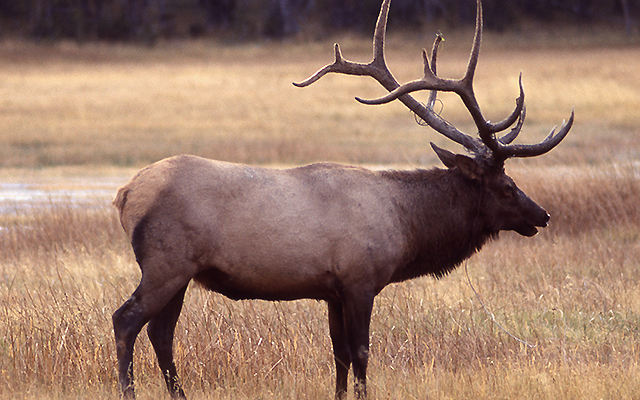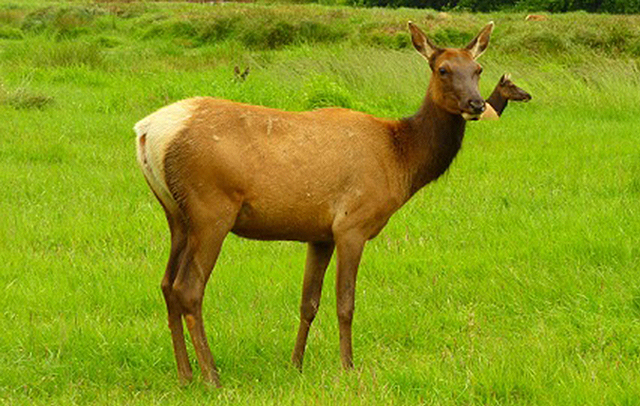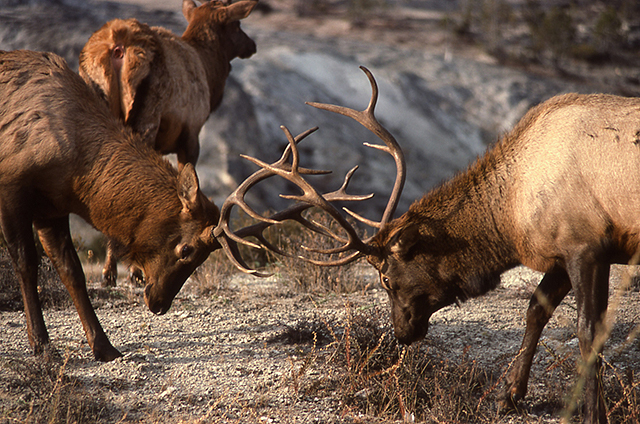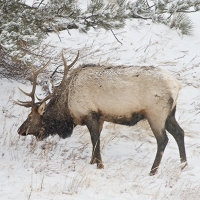One of these quintessential holiday images was almost lost forever over 100 years ago. Once plentiful in 52 of Wisconsin’s 70 counties, the elk (Cervus canadensis) was extirpated from the state by the late 1880’s. Realizing the monumental loss of such a majestic creature, scientists tried unsuccessfully to reintroduce a herd back to Wisconsin in the 1930’s before illegal poaching led to their demise again by the end of the 1940’s. It was not until the 1990’s that wildlife biologists again attempted to reintroduce elk into the Wisconsin’s wild. The goal? To establish an elk herd that would eventually grow to nearly 1,400 individuals.

And grow the elk herd did, slowly but steadily. Now around 160 individuals, Wisconsin’s Clam Lake herd has experienced an average 7% growth rate since 1995. Successful enough in fact, that a couple of years ago, wildlife biologists decided to begin establishing a second elk herd in the Black River State Forest area in Wisconsin. In 2015, 23 elk from Kentucky were released into Jackson County. Thirteen of those elk survived, and in 2016, 50 new elk were released into the same area. The ultimate goal of the Jackson County herd is 390 elk. While still a bit early to tell the fate of the Black River State Forest population, Wisconsin Department of Natural Resources officials involved in the project seem optimistic about the new herd’s chances of surviving.
An elk is distinguished from a deer by its stubby white tail which is surrounded by a buff, white-colored patch. They have a thicker, longer neck than deer and a long shaggy beard. Additionally, the antlers of male elks are thicker and rounder-shaped than those of the more diminutive deer. It is also interesting to note that elk, not deer, were the dominant cervid of Wisconsin when settlers arrived. The altered landscape of Europeans has since favored the more opportunistic deer.

The crepuscular elk lives in habitats of prairie, open meadows, or grassy fields interspersed with forested woodlands. Habitat preference has proved to be a sizable hurdle in Midwest elk reintroduction. Much of the prairie and meadow habitat that elk prefer was lost in the Great Lake’s region before the early 1900’s. So to sustain a healthy herd in modern times, extensive habitat management efforts (and funds) must be constantly considered.
Elk eat a variety of foods and change their feeding habit and diet seasonally. Elk graze on tender young grasses and forbs in spring and summer, then in fall and winter they become more of a browser, picking off twigs and bark from trees. However elk have a much stronger preference for grazing and they often trample down snow to get to the luscious greens beneath. Enticing patches of food are noted by telltale elk droppings and small, heart-shaped hoof prints.
Perhaps elk would have made an excellent sleigh team for Santa because they are rather communal creatures by nature. In winter, elk gather in large groups of females and males together. In spring and summer, females and young typically live together in bands of roughly 5-30 individuals, while males tend to live either solitarily or in smaller bands away from females. In fall, the social structure shifts again as males become more dominant and control harems.
Rutting (breeding) season marks a period of extreme behavior in the elk world. Come September, bulls become extremely territorial and will fight furiously to obtain dominant male status. They note their territory with vocalizations and a musk excreted by glands in their muzzle and chin. Their antlers are used to battle other males with bullying, shoves, jousts, and clashes.

The male will take on a harem of up to 20 cows (larger elk herds outside Wisconsin rule harems of up to a couple hundred cows) once dominance is established. The bull uses a variety of methods to attract cows, performing grunts, bugles, and ground scrapes to further entice them. And he will be the only male to mate with the female when she comes into heat.
The female goes through a 250-day gestation and gives birth to a single, approximately 35-pound spotted calf in the spring. The calf is weaned by rutting season and will stay with the female until the following spring. Most elk become sexually mature by age two, but choose not to breed until at least three years of age, even four or five since he will likely be too small to win a harem until he grows older.
The oldest living elks exist in captivity and are over 20 years of age. In the wild, elk typically live less than 10 years, with females often outliving males. It is thought that this is because of injuries that males suffer as a result of territory battles during breeding season and human desire to harvest males for their antlers.
Wolves, coyotes, and black bears prey upon young, sick, or old elk. Unfortunately, humans contribute to the early demise of many elk too. Car strikes and poachers kill many each year. Between May of 2015 to 2016, seven mortalities were witnessed in the Clam Lake herd — three by wolves, one due to a rut fight, two car collisions, and one poaching.
Fun Facts:
- Faster than a speeding bullet! Elk are incredibly quick and males can reach speeds of 35 mph! For comparison, the world’s fastest human (Usain Bolt) can only briefly sustain speeds of 28 mph.
- A sailor’s life isn’t half bad. Elk (along with their caribou and moose cousins) are excellent swimmers. In fact, whole herds will traverse streams, rivers, and even oceans together to get to a new location quickly.
- This moss hat is all the rage in Paris. During rutting, a bull elk will often tear up vegetation and leave it dangling off his antlers to display dominance.
- Creepy crawlies have to make a living too... Elk (along with other ungulates) are susceptible to the meningeal worm (Parelaphostrongylus tenuis). This parasitic nematode lives in the lining of the brain and spinal cord and can cause severe nerve damage or even death. And you thought tape worms were bad!
- Cupid the elk? Many Native American tribes view the elk as a symbol of love. Legends say the elk created the first flute (probably in reference to how the male bugles during rutting), which was once used in some native cultures by men to woo women.
*This article was written using references from Allen Kurta’s, “Mammals of the Great Lakes Region” and Stan Tekiela’s “Mammals of Wisconsin” and the websites - dnr.gov, Wikipedia.com, clamlakewi.com, and youtube.com





